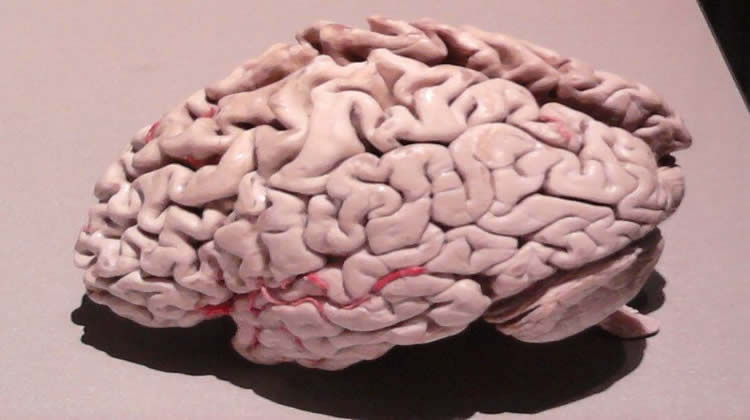Findings may influence strategies for treatment.
A recent study conducted at Nathan S. Kline Institute for Psychiatric Research (NKI) and NYU Langone Medical Center implicates a new culprit in Alzheimer’s disease development. The research reveals that ßCTF — the precursor of the amyloid beta (Aß) peptide — acts at the earliest stage of Alzheimer’s to initiate a range of abnormalities leading to the loss of groups of neurons critical for memory formation. Results from the study are published online July 21, 2015 in the journal, Molecular Psychiatry, and the article has been selected for an issue cover.
The recent study findings involving ßCTF have significant implications for treatment strategies and furthering the course of Alzheimer’s drug development. Presently, the most common strategy for treating Alzheimer’s disease is targeting the amyloid ß peptide, which has had modest success in clinical trials. Findings from this research suggest that drugs that may reduce βCTF levels as well as beta-amyloid, such as the class of BACE1 inhibitors currently under development, may help slow or stop the progression of Alzheimer’s disease.
βCTF is formed during endocytosis, the process by which cells absorb nutrients and sample various materials from the outside environment. It has been known for some time that abnormalities of endocytosis develop very early in Alzheimer’s disease, well before clinical symptoms, and that variant forms of genes controlling endocytosis are frequently implicated as risk factors promoting Alzheimer’s. Endosomes — the membranous vesicles mediating endocytosis — start to swell abnormally in some neurons beginning even in infancy in Down syndrome – a developmental disability that almost invariably leads to early-onset AD. Research indicates that more than 75 percent of those with Down’s, aged 65 and older, have Alzheimer’s disease.

The NYU Langone – NKI research team led by Ralph Nixon, MD, PhD, professor in the departments of psychiatry and cell biology at NYU Langone School of Medicine and director of the Center for Dementia Research at the Nathan S. Kline Institute for Psychiatric Research found that, in Alzheimer’s and Down Syndrome, βCTF forms more rapidly on endosomes triggering a molecular pathway leading to loss of neurons involved with memory. The researchers discovered APPL1, a protein unrelated to amyloid precursor protein (APP) despite its similar acronym, directly links βCTF to a second protein, rab5, known to activate the molecular chain of events leading to neurodegeneration. Lowering APPL1 levels in cells of individuals with Down syndrome abolished the abnormal endocytosis, indicating the vital role of APPL1 in this molecular cascade. The identification of APPL1 as the missing link in a well-described chain of events associated with very early Alzheimer pathology implies a direct contribution of ßCTF to Alzheimer’s disease development. Notably, a recently discovered APP mutation that uniquely lowers, rather than raising, risk for Alzheimer’s is believed to act by slowing the formation of ßCTF.
While the current findings do not place any more or less importance to Aß as a culprit and a target for Alzheimer’s therapy, they now underscore the importance of ßCTF as a key contributor to disease development. “It will be important to consider the role of βCTF in the design of future therapies for Alzheimer’s disease and in the interpretation of current clinical trials of BACE1 inhibitors. BACE1 inhibitor trials have been considered a test of the Aß/amyloid hypothesis but the primary action of these inhibitors is actually to block formation of ßCTF, the precursor of Aß,” said Ralph A. Nixon, MD, PhD.
Funding: Funding for the study was provided by the NIH/National Institute on Aging.
Source: Camy Sleeman – Nathan S. Kline Institute for Psychiatric Research
Image Credit: The image is in the public domain
Original Research: Full open access research for “Evidence that the rab5 effector APPL1 mediates APP-βCTF-induced dysfunction of endosomes in Down syndrome and Alzheimer’s disease” by S Kim, Y Sato, P S Mohan, C Peterhoff, A Pensalfini, A Rigoglioso, Y Jiang and R A Nixon in Molecular Psychiatry. Published online July 21 2015 doi:10.1111/desc.12323
Abstract
Evidence that the rab5 effector APPL1 mediates APP-βCTF-induced dysfunction of endosomes in Down syndrome and Alzheimer’s disease
β-Amyloid precursor protein (APP) and its cleaved products are strongly implicated in Alzheimer’s disease (AD). Endosomes are highly active APP processing sites, and endosome anomalies associated with upregulated expression of early endosomal regulator, rab5, are the earliest known disease-specific neuronal response in AD. Here, we show that the rab5 effector APPL1 (adaptor protein containing pleckstrin homology domain, phosphotyrosine binding domain and leucine zipper motif) mediates rab5 overactivation in Down syndrome (DS) and AD, which is caused by elevated levels of the β-cleaved carboxy-terminal fragment of APP (βCTF). βCTF recruits APPL1 to rab5 endosomes, where it stabilizes active GTP-rab5, leading to pathologically accelerated endocytosis, endosome swelling and selectively impaired axonal transport of rab5 endosomes. In DS fibroblasts, APPL1 knockdown corrects these endosomal anomalies. βCTF levels are also elevated in AD brain, which is accompanied by abnormally high recruitment of APPL1 to rab5 endosomes as seen in DS fibroblasts. These studies indicate that persistent rab5 overactivation through βCTF–APPL1 interactions constitutes a novel APP-dependent pathogenic pathway in AD.
“Evidence that the rab5 effector APPL1 mediates APP-βCTF-induced dysfunction of endosomes in Down syndrome and Alzheimer’s disease” by S Kim, Y Sato, P S Mohan, C Peterhoff, A Pensalfini, A Rigoglioso, Y Jiang and R A Nixon in Molecular Psychiatry. Published online July 21 2015 doi:10.1111/desc.12323







